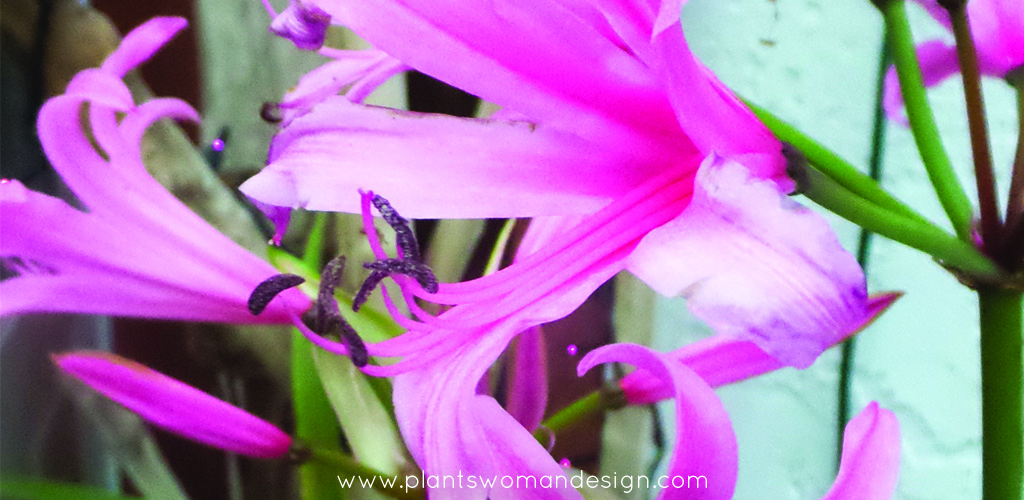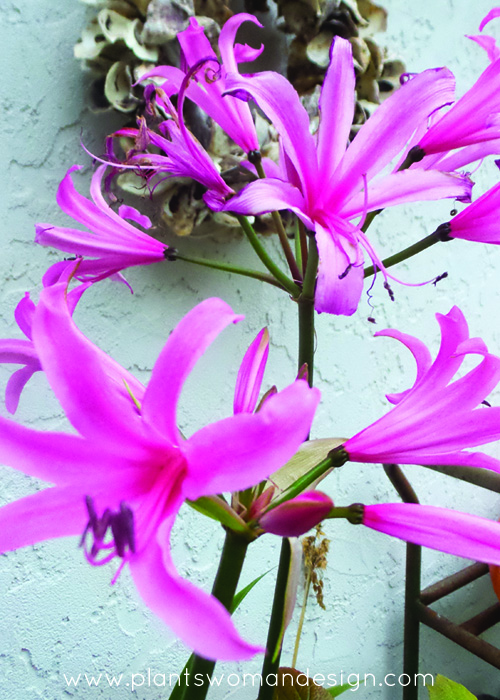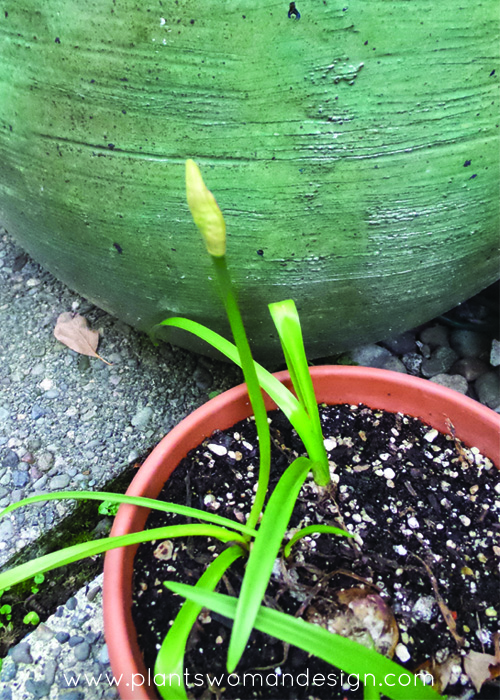Naked Ladies…
Sometimes common names are a little risqué, right? Naked Ladies is the common name of the Nerine, so called because they bloom without leaf. It is always good to be sure that you have the right plant and get the botanical name.
I love Nerine bulbs. I first read about them in 1997 in a Garden Design Magazine from the UK and wrote about them last year in my fall bulb post. I’ve seen them planted by people long gone and growing in unexpected places. They are so surprising at this time of year. Everything is red, gold, and orange, but then an unexpected blast of pink dancing through the autumn blaze.
Many of them are not very hardy in our area because they originally come from South Africa.
The nerine bowdenii is the hardiest and easiest one to find. I found some fabulous fat bulbs blooming at Ravenna Gardens last week. I also have some in the garden that I got online last winter. They are still small and are just starting to put out one bloom. Looking at the size of the bulbs I can see the ones in my garden need to put on a lot more girth before they are as fabulous as the ones I found at Ravenna Gardens.
Here’s a little history for you… Nerine bowdenii is one of the stars of the fall garden. Natives of southern Africa there are 24 species. Growers have been busy hybridizing these lovely bulbs and have produced umpteen cultivars. Two names come readily to mind. The first to be introduced was Nerine sarniensis – the Guernsey Lily – and was described in 1635 by a French physician, Jacob Cornut. The story of its introduction to Guernsey is not clearly known. It was thought that the bulbs had come from Japan, but Nerine sarniensis is native to the cliffs of Table Mountain and was loaded on to a Dutch East India Company vessel which called for fresh supplies at Capetown. This vessel is rumored to have grounded on Guernsey and the bulb was given to the Jurat, John de Sausmarez in gratitude for hospitality before 1655. Linnaeus named it Amaryllis sarniensis in his Species Plantarum in 1753, but it was subsequently named Nerine, (after the sea nymph), by William Herbert (1778-1847), in 1820. Nerine sarniensis comes from the summer-dry region of South Africa and flowers as the leaves are developing.
Nerine bowdenii on the other hand comes from the summer rainfall area of Eastern Cape Province and the Drakensburg mountains, where in grows in moist soil at the foot of cliffs. It is named for the British surveyor, Athelstan Hall Cornish- Bowden (1871-1942) who sent bulbs to Britain in 1899. It was described by William Watson (1858-1925) in 1904 and featured in Curtis’s Botanical Magazine tab. 8117 in 1907. It flowers, after the leaves have withered, in October and November and is quite hardy, gradually building up into large clusters of bulbs. Nerine bowdenii is a bulbous, herbaceous plant with flower spikes to about 18” (50cm). The flower color is bright pink with recurved tepals. The flowers are long lasting and floriferous.
There is a Nerine and Amaryllid Society with members around the world. In our area one of the coolest places to get them is close to us – the Pacific Bulb Society. The trick is that they don’t sell the bulbs you have to become a member to join the bulb exchange. It’s great to join a society like this to promote exchange and preservation of bulbs and plants. I have also purchased my Nerine bulbs from Amazon. They came all the way from Africa and it was exciting to have a package from far away show up at your door with plants.
Cultivation: Nerine bowdenii is perfectly hardy in zone 7 with good drainage. The bulbs should be left undisturbed to bulk-up. Flowering is enhanced by the bulbs over-crowding. The bulbs of Nerine bowdenii need summer moisture where as those of Nerine sarniensis should be allowed to dry-off during the summer. The bulbs should be half-buried with the long “neck” above ground. Planting against a wall in a good loam is ideal.
Propagation: Division of the bulbs is by far the easiest method of increase. Seeds, which are readily produced, should be sown immediately on ripening and just pressed into a seed pan. Flowering will take 5 years and the outcome might produce new flower colors.




